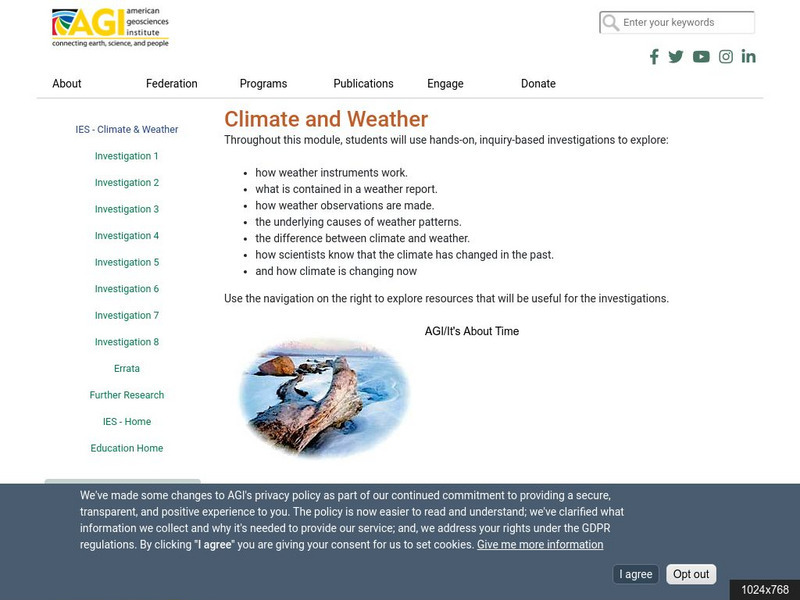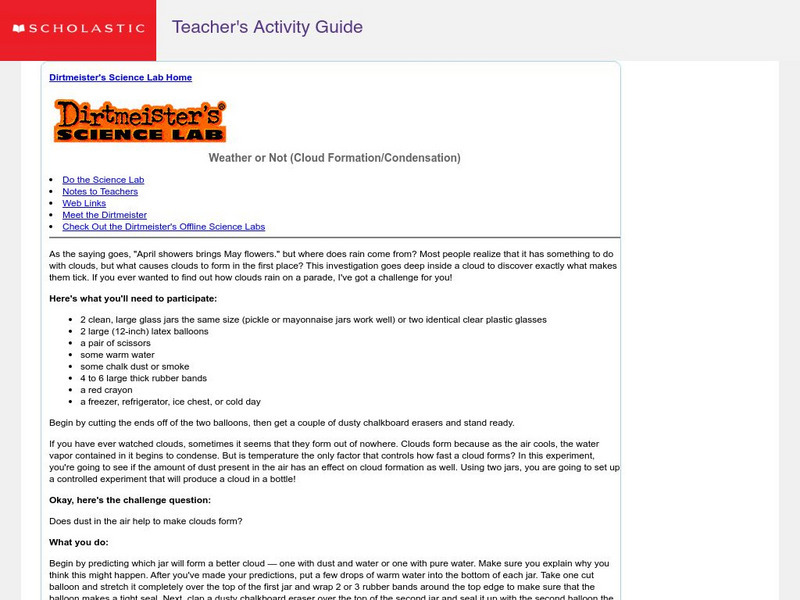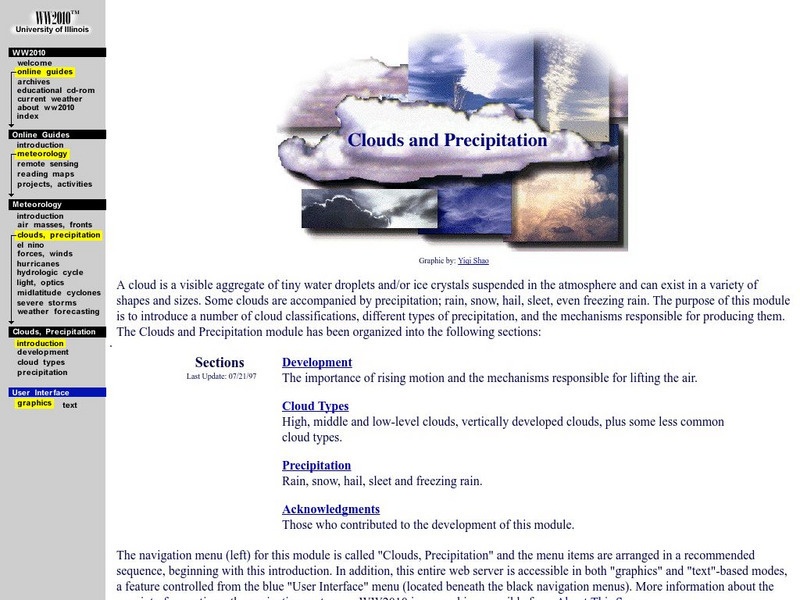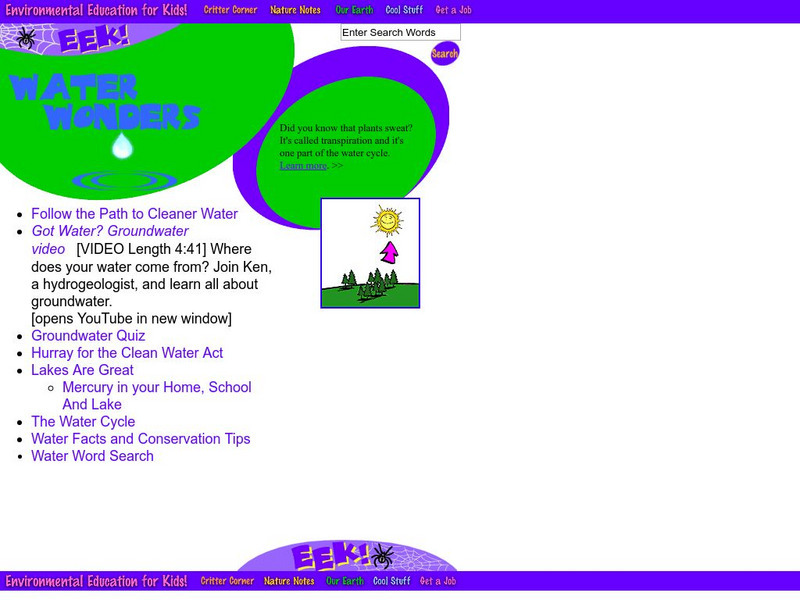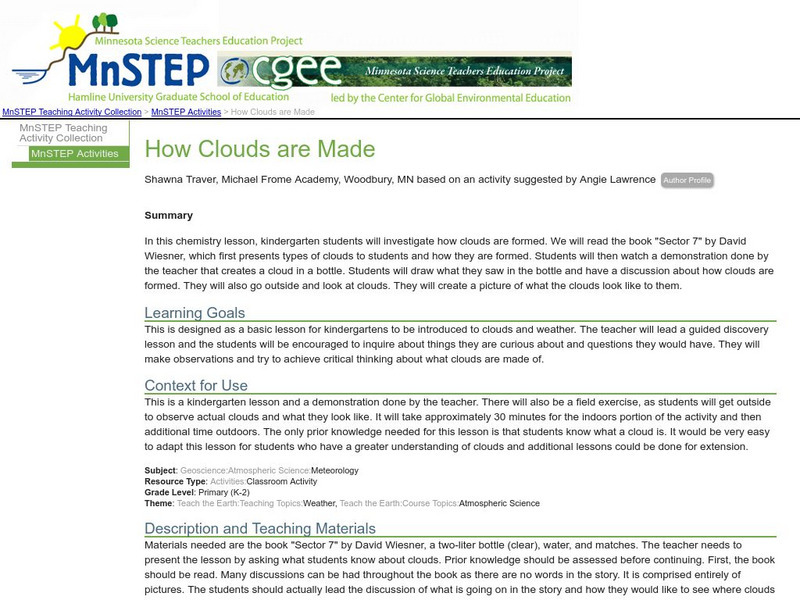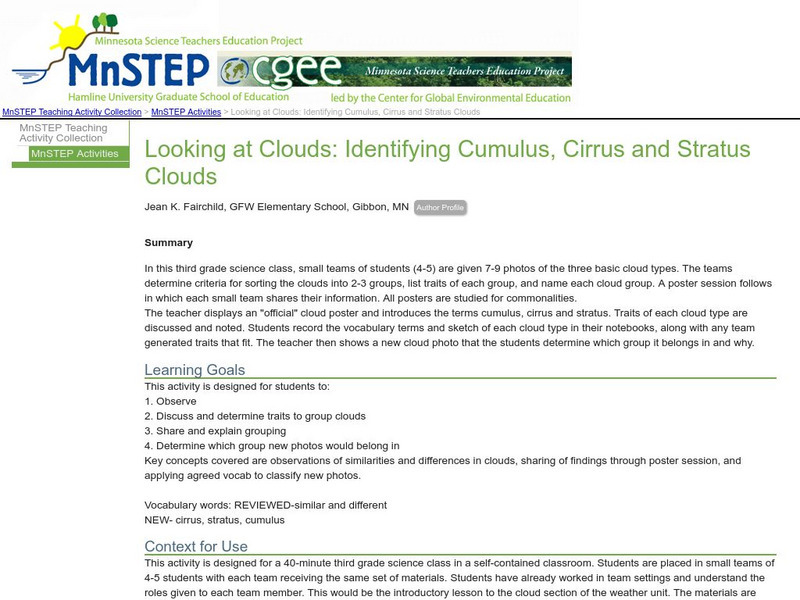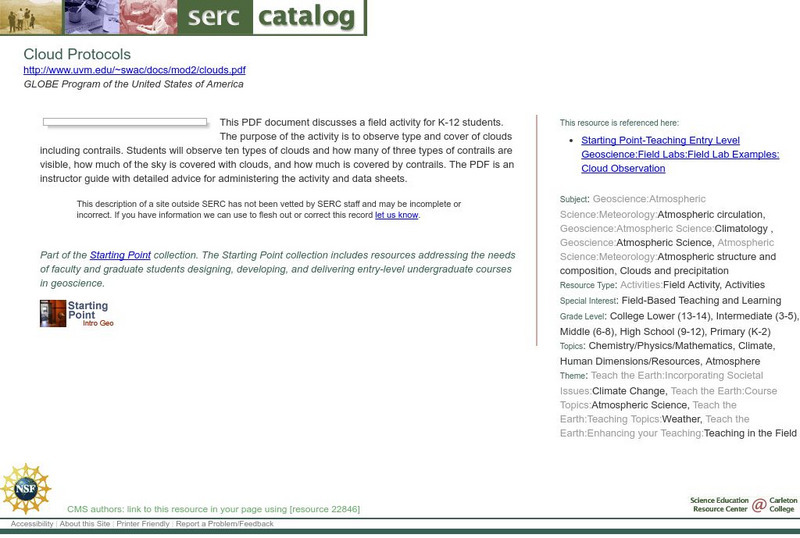Globe
The Globe Program: Clouds Module
Activities give students the opportunity to describe the shape and appearance of cumulus clouds and learn the types of weather that are associated with them. They identify cloud types using cloud classification names and explore the...
University Corporation for Atmospheric Research
Ucar: Elementary Globe: To Spread or Not to Spread
Learners will explore the difference between the three types of contrails. Then they will make observations of contrails outside, record their observations, and then make follow-up observations 15 minutes later to see how the contrails...
OpenSciEd
Open Sci Ed: 6.3 Weather, Climate & Water Cycling
Why does a lot of hail, rain, or snow fall at some times and not others? This unit contains four separate lesson plan sets built around answering this question. In the first two lesson plan sets, students explain small-scale storms. In...
American Geosciences Institute
American Geosciences Institute: Climate and Weather
Eight hands-on lessons module in which students explore climate and weather. Inquiry-based investigations include observing weather, weather reporting, weather maps, weather satellites, causes of weather, and climate change.
Australian Broadcasting Corporation
Australian Broadcasting Corporation: News in Science: Soaring the Glory
Absolutely fascinating site on an interesting cloud phenomenon called the Morning Glory! Discover something new as you learn all about this massive backwards-rolling cloud formation.
Scholastic
Scholastic: Dirtmeister's Science Lab: Weather or Not
Simple experiments for exploring clouds and cloud formation. You'll find out whether dust in the air helps cloud formation and discuss how dust helps meteorologists make weather predictions.
University Corporation for Atmospheric Research
Ucar: Clouds [Pdf]
Teachers and/or students are given four science experiments related to clouds in our atmosphere. Photos and brief descriptions of the main types of clouds ..Cirrocumulus, Cirrus, Altocumulus, Cumulus, Cumulonimbus, Stratus .. are included.
University of Illinois
University of Illinois Urbana Champaign: Cloudsand Precipitation
Find out about the development of clouds, types of clouds, and precipitation. Includes diagrams and illustrations.
University Corporation for Atmospheric Research
Ucar: Web Weather for Kids: Create a Portable Cloud
Using six common objects you can make a portable cloud. Get all the directions you need at this site.
Texas Instruments
Texas Instruments: Clouds
This activity is designed to assess a student's comprehension of a basic meteorological phenomenon.
Environmental Education for Kids
Eek!: Water Wonders
This site from the Environmental Education for Kids contains colorful and detailed information on water resources. Site covers fascinating tips and facts, as well as engaging quizzes on the wonderful world of water. Best suited for...
Science Education Resource Center at Carleton College
Serc: Investigating How Do Clouds Form? What Are the Different Types of Clouds?
In this investigation, young scholars will observe and learn about the different types of clouds and be able to explain in their own words how clouds are formed. They will also observe an experiment illustrating how clouds form.
Science Education Resource Center at Carleton College
Serc: Looking at Clouds: Making a Book That Identifies Cloud Types
While creating their own cloud book, young scholars will identify and classify the different cloud types and the weather conditions that they bring.
Science Education Resource Center at Carleton College
Serc: How Clouds Are Made
Introduce young learners to clouds and weather with guided discovery and inquiry to learn what makes up clouds.
Science Education Resource Center at Carleton College
Serc: Identifying Clouds
Young scholars work together to learn how to identify clouds. They take pictures, create models, and identify various forms of clouds. Since this is an immersion setting, students also learn the names of the clouds in the German language.
Science Education Resource Center at Carleton College
Serc: I Can Forecast the Weather
The learners will study and be able to tell the difference between cumulus, cirrus, and stratus clouds. As they tell the difference they will be able to tell what the weather will be like.
Science Education Resource Center at Carleton College
Serc: Cloud Inquiry Investigation & Id
Students describe and create an experiment to indicate that a cloud will form under specific conditions.
Science Education Resource Center at Carleton College
Serc: Looking at Clouds: Identifying Cumulus, Cirrus and Stratus Clouds
Using photos of the three basic cloud types, small groups of students will sort the clouds into 2-3 groups, list traits of each group, and name each cloud group. They will share their information on posters which are studied for...
Science Education Resource Center at Carleton College
Serc: Cloud Protocols
Students observe ten types of clouds and visible contrails, and determine how much of the sky is covered with clouds or contrails.
Encyclopedia of Earth
Encyclopedia of Earth: Clouds
Explains what clouds are, how they are formed, and provides a chart listing the four main categories of clouds in the Earth's atmosphere - cirrus, nimbus, cumulus, and stratus. (Updated: July 25, 2012)
TED Talks
Ted: Ted Ed: Why Aren't We Only Using Solar Power?
Solar power is cheaper and more sustainable than our current coal-fueled power plants, so why haven't we made the switch? The real culprits here are the clouds, which make solar power difficult to control. Alexandros George Charalambides...
TED Talks
Ted: Ted Ed: How Did Clouds Get Their Names?
Richard Hamblyn tells the history of Luke Howard, the man who classified the clouds and forever changed humanity's understanding of these changeable, mysterious objects. [5:07]
Dan Satterfield
Dan's Wild Weather Page: Clouds
Find out all about clouds and how they are formed at this site from Dan's Wild Weather Page. Nice photographs of different types of clouds enrich the site.

